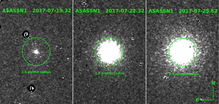ASASSN1
Comet ASASSN1 (IAU designation C/2017 O1) is a comet discovered by the All Sky Automated Survey for SuperNovae (ASAS-SN). It was first detected on July 19, 2017, located in the southern constellation Cetus.
 The Comet's perihelion is just outside of the orbit of Mars on October 14, 2017. | |
| Discovery | |
|---|---|
| Discovered by | All Sky Automated Survey for SuperNovae |
| Discovery date | July 19th 2017 |
| Alternative designations | C/2017 O1 |
| Orbital characteristics [ A] | |
| Epoch | 2017-Aug-24 (JD 2457989.5) |
| Observation arc | 73 days |
| Perihelion | 1.4987 AU |
| Eccentricity | 0.99658 |
| Orbital period | ~8600 yr (inbound) ~8200 yr (outbound) |
| Inclination | 39.849° |
| Node | 25.810° |
| Argument of periapsis | 20.907° |
| Earth MOID | 0.534 AU |
| Jupiter MOID | 2.27 AU |
| Last perihelion | 2017-Oct-14 |
Discovery

During the ongoing ASAS-SN survey, using data from the quadruple 14-cm "Cassius" telescope on Cerro Tololo, Chile, a possible new moving transient source was detected on July 19, 2017; the team gave it the designation ASASSN1. [1]
In the discovery images, ASASSN1 had a V band magnitude of 15.3. The centroid was moving between the ASAS-SN three 90 second, dithered discovery images with no counterpart in the Minor Planet Center database. Follow-up images from the Savannah Skies Observatory recovered ASASSN1 9.7 hours later 0.21 degrees away. These observations revealed Comet ASASSN1 had a halo at least 25 arcsec in radius, a compact core, and no clear tail. Further observations were made using the Las Cumbres Observatory 1m at CTIO 24.7 hours after discovery which recovered ASASSN1 at a g-band magnitude of 15.2. ASASSN1 was then found 0.77 degrees away from ASASSN1's original location 35.7 hours after discovery. ASAS-SN's Cassius unit re-observed this field 3 days after discovery and found that ASASSN1 significantly brightened to V band 11.9 magnitude. In addition to brightening, the coma around ASASSN1 also increased significantly to 2.5 arcmin. Finally, the northern ASAS-SN unit, a quadruple 14-cm "Brutus" telescope on Haleakala Hawaii, observed ASASSN1 6 days after discovery and found that ASASSN1 appears to have faded to V~12.2.
Trajectory in sky
The comet was discovered in Cetus in July, moving into Taurus in September, and Perseus and Camelopardalis in later September and early October. Its perihelion is on October 14, and closest to the earth on October 18. It moves towards the north pole and northern Cepheus into December.[2]
 |
| This chart shows its weekly motion across the sky. |
References
- Prieto, Jose (July 25, 2017). "ASASSN1: Bright Comet Discovered by the All Sky Automated Survey for SuperNovae". Retrieved July 25, 2017.
- https://www.universetoday.com/136564/new-comet-c2017-o1-asas-sn-takes-earth-surprise/
External links
- New Comet: C/2017 O1 ASAS-SN Takes Earth by Surprise 27 Jul, 2017
- Sky Surprises: New Comet ASASSN1, Nova in Scutum, and Supernova in Pisces! July 26, 2017
- How to see binocular comet C/2017 O1 September 18, 2017

